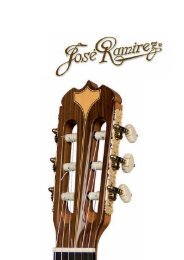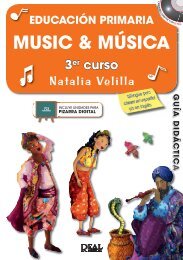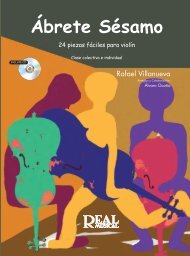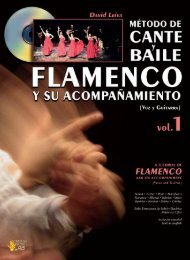Create successful ePaper yourself
Turn your PDF publications into a flip-book with our unique Google optimized e-Paper software.
22<br />
HISTORY<br />
The flamenco guitar, a mix of the tradition of the popular strummed guitar with<br />
the “Andalusian airs” of the nineteenth-century concert players<br />
The doctoral thesis (1) shows and concludes that the flamenco guitar has evolved from the mixture of a<br />
long Spanish tradition of popular strummed guitar, and the repertoire of “Andalusian airs” made popular<br />
in the second half of the nineteenth century by concert guitarists, who directly or indirectly were disciples<br />
of the Dionisio Aguado school of guitar. What follows is a summary of these main musical<br />
transformations, which are also related to structural changes in the instrument itself.<br />
The concept of “popular guitar” first appears in Andalusia as a four-course guitar characterized by a<br />
simple manner of accompaniment compared to the more sophisticated methods of playing the vihuela.<br />
Sources from the sixteenth century indicate that the guitar was commonly used to mark rhythm, using<br />
rasgueado, one of the basic techniques of flamenco guitar. Vihuelists based some of their own repertoire<br />
on popular music, and their method of composing variations called “diferencias”, continued later in<br />
flamenco guitar playing as “falsetas”.<br />
Seventeenth century sources show the use of different combinations of rasgueado in the main European<br />
countries, which were most commonly used in the accompaniment of Spanish dances. This guitar has five<br />
courses and became internationally known as the “Spanish guitar”, which was used to play dance rhythms<br />
by plucking and strumming, and was generally accompanied by different percussion instruments. An<br />
analysis of baroque repertoire shows how different rhythmic, harmonic and melodic aspects crystallized<br />
to form part of flamenco guitar and dance. This holds in the relationship between “diferencias” and<br />
falsetas, and popular music as a source for writing music in tablature.<br />
According to sources from the eighteenth century, the baroque aesthetic of rhythmic guitar predominated<br />
at that time. Cadiz also became well known for its guitar production and guitar scene. An analysis of<br />
repertoire shows once again the mutual influences between popular and academic guitar. New forms<br />
burst out to inherit the old, such as the fandango and the jota. The former, documented since 1705,<br />
contains the definitive harmonic basis of flamenco guitar, the harmonization of the Andalusian cadence,<br />
while also maintaining the culture of composing short variations on popular motifs. The guitar’s<br />
construction in five courses combined with musical sources, allow us to conclude that the “toque por<br />
medio” or “playing in the mode of A” was the first style of “toque” to appear in the history of flamenco<br />
guitar.<br />
MUESTRA<br />
In the second half of the eighteenth century structural changes occurred when an extra sixth course was<br />
added to the guitar, with Cadiz as a centre. This resulted in the division of two great guitar schools, the<br />
rhythmic guitar of accompaniment, (which re-appears later with flamenco guitar), and the more<br />
sophisticated plucked guitar as the future of classical concert guitar. The literary sources bear testimony<br />
to the constant presence of the popular strummed guitar in Spain, particularly in Andalusia. Musical<br />
sources revealed the development of a theory to find a new sound and technique, which elevated the guitar<br />
from “rough” or “noisy music”. This was a necessary step to reach the level of the other relevant<br />
instruments of the period, like the violin and the piano.






